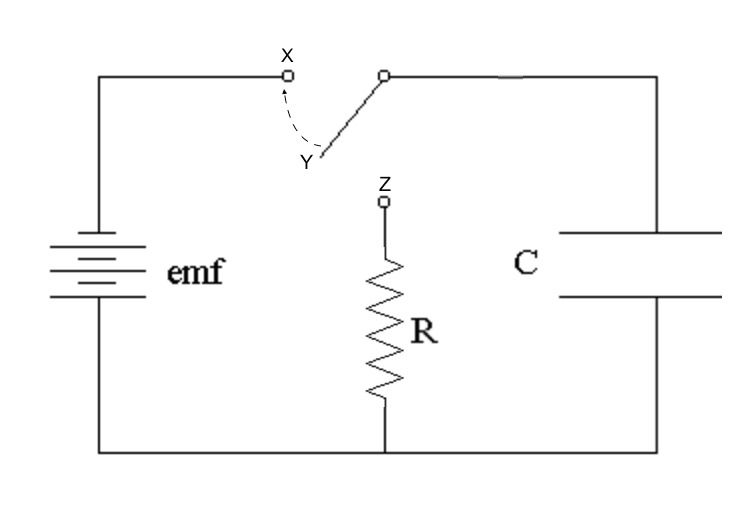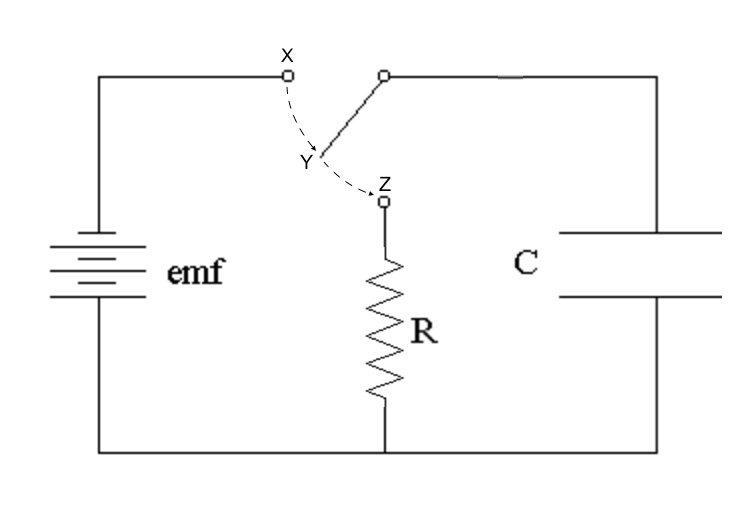Non Steady State
by Javier Rodriguez
RC circuits in non-steady state are defined by changing charges, currents, and voltages as a function of time.
In other words, Q’(t) ≠ 0
Non-steady state circuits are specifically important when analyzing the charging or discharging a capacitor. Surely, when a capacitor fully charged (Q/C = Emf) or fully discharged (Q=0), the circuit is in steady state — the derivative of charge with respect to time is 0.
Mathematical Applications
The main two facets of non-steady state circuits, for the purposes of this course, cover the charging and discharging of capacitors. Mathematically, an exponential change occurs when the derivative of a quantity has a relation to the quantity itself. We'll be applying this to the charge and discharge of capacitors, with varying circuit arrangements dependent on switches. Note that throughout these examples, we'll be using the Loop Rule (more formally known as the Kirchoff's Voltage Rule) -- but not in terms of steady state. That is, the more familiar variation (∆Vloop = 0) doesn't apply in this case, as it details the circuit at the endpoints of the timeframe, or steady state. Through these few examples, we'll be looking at the intermediate moments of a given time frame.
Example 1: Charging a Capacitor
To better understand this, let’s take a look at a simple RC circuit consisting of a battery Emf, a resistor of resistance R, and a capacitor with a capacitance C.
Assume that the capacitor initially has a charge of Q=0. While the switch remains open at location Y, there is no current flowing through the circuit.
The moment the switch closes at location X, the voltage across the capacitor does not instantaneously equal the Emf of the battery. A current initially starts to flow, which allows charges to collect on the plates of the capacitor. At this moment, Q’(t) > 0. As time passes, the charges continue to build up, which permits less current to pass through the capacitor — causing the current to decrease under an exponential decay, I’(t) < 0.
Because the voltage drop across a capacitor is directly proportional to charge, this voltage follows the same trend. To find the the exact voltage drop across the plates at any given time t, we can use the following exponential equations:
V(t) = Emf (1 - e-t/RC)
Looking at this equation, we see that as time increases, e-t/RC grows increasingly smaller. After enough time passes, this value will approximate at 0, leaving the voltage at time t to resemble:
V(t) = Emf
At this moment, the capacitor will be fully charged, and no current will flow through the circuit.
Example 2: Discharging a Capacitor
Very similar to charging a capacitor, the discharging of a capacitor involves a time period when the derivatives of charge and current are nonzero. The given circuit is once again in non-steady state.
Consider the same circuit below. Assume the switch the switch was at location X for a very long time, and the capacitor is fully charged.
The moment the switch is moved to location Z, the capacitor supplies a voltage, with an Emf equal to that of the battery. As current begins to flow, the charges on the plates grow increasingly smaller with time. Because of this, both the capacitor’s voltage and the current flowing through the circuit are also decreasing.
Using a slightly modified equation, we can also find the exact voltage of the capacitor at an arbitrary time t.
V(t) = Emf (e-t/RC)
Using this equation, we clearly see that initially at t=0, the voltage equals Emf. However, as the elapsed time gets larger, we notice that V(t) will grow increasingly smaller, eventually reaching an approximate value of 0. When this occurs, it indicates that the charges on the capacitor plates are also 0, meaning the current has stopped flowing.
It’s interesting to note that if the resistor were, for example, a lightbulb, the exponential decay of the current passing through the lightbulb would inevitably cause the lightbulb to shine its brightest at time t=0, and grow increasingly dimmer as the capacitor discharges. When the capacitor is fully discharged, as mentioned above, the current will be 0, and the lightbulb will go out.
Connectedness
This topic is particularly relevant to Electrical and Computer Engineering majors. For more information on its applications, jump to Further Reading.
See also
Are there related topics or categories in this wiki resource for the curious reader to explore? How does this topic fit into that context?
Further reading
Books, Articles or other print media on this topic
External links
Internet resources on this topic
References
This section contains the the references you used while writing this page

